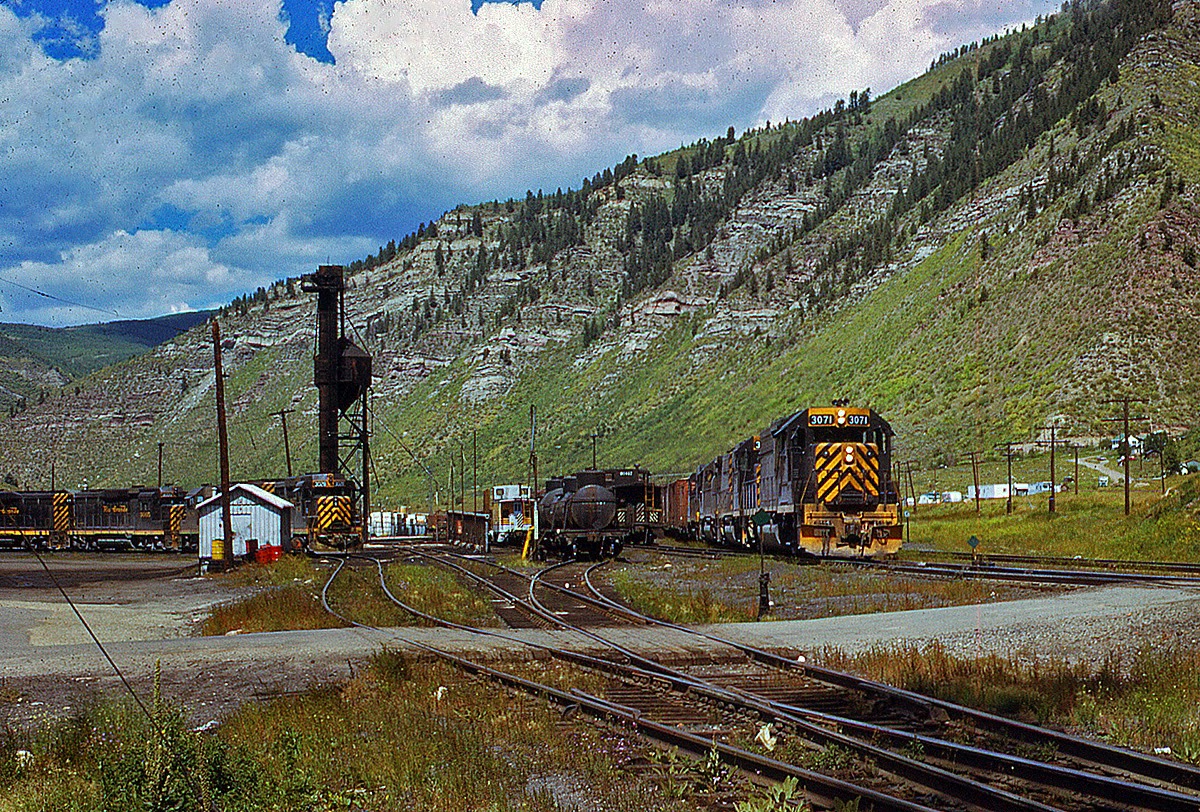Posted by Unknown on 5:00 PM in 1968, 2, 3071, at, CO, DRGW, July, Minturn, Throwback, Thursday | No comments
 |
| DRGW GP40 #3071 pauses at Minturn, CO in July 1968. John W. Maxwell photo, author's collection. |
One hobby of mine is collecting and trading 35mm photographic slides of trains and railroad equipment. Last year, I acquired a small part of the photographic collection of John W. Maxwell, a photographer well-known among the narrow gauge community in the western United States. From the information I could gather, John was a mechanical engineer who was employed by Union Pacific in Colorado. I believe he lived in Denver, although that is only a guess based upon where the bulk of the photos were taken. John was popular among narrow gauge enthusiasts for his extensive photography of narrow gauge equipment and for making highly accurate scale drawings of narrow gauge rolling stock and equipment. John took photos for over 60 years, and from what I can find on the internet, the location of the bulk of his photographic and drawings collection remains a mystery. But instead of dwelling on where the collection went, let’s enjoy the view he captured in the photo above.
We’re at Minturn, Colorado in July 1968 – the sanding tower in the photo easily recognizable to any fan of The Mainline Through the Rockies. In this view we find one-and-a-half year old GP40 #3071 leading an eastbound that has stopped at the yard. Minturn is located on the west side of the infamous Tennessee Pass, and is a town long associated – and closely tied to – the railroad. It was here that nearly all eastbound trains stopped and had helpers added to the train in order to overcome the 3% grades further up the pass. Though the train is eastbound, the tracks here run almost north-south allowing for good lighting of eastbounds almost all day long; it appears to be perhaps late morning at this click of the shutter. By this point in time, the 26 SD45’s are all on the property, but the railroad is still largely dominated by turbocharged four-axle locomotives, as evidenced by the consist of this train as well as the power in the distance. It would be another six years before the tunnel motors synonymous with the DRGW in its’ later years would show up, and we’re still not quite into EMD’s Dash-2 era yet
. We can safely surmise that the three GP30’s and a unit hidden by the shed are a helper set that perhaps will cut in partway back in this train, or another eastbound later in the day. Between the two lashups are no less than four (!) GP30’s along with an equal number of GP40’s or GP35’s. What a sound it must have been to hear this train leave town!The lead unit, DRGW 3071 would go onto have a long and interesting history (most information from Don Strack’s Utah Rails site). It was the third of twelve GP40’s delivered to the Rio Grande in early 1967, and one of many high-horsepower four axle units that the railroad owned. The unit was converted into a trailing-only unit (“B-unit”) in 1972 with the removal of the radio, cab seats and other lead-required equipment; 24 other GP40’s and a number of GP30’s and GP35’s were similarly modified in an effort to reduce operating costs. The engine remained in this condition for many years and into the Southern Pacific era, when it was returned to a lead-capable unit. Eight years after the Rio Grande – Southern Pacific merger in 1988, the engine became part of the massive Union Pacific system in 1996. Under UP ownership, the engine left home rails and travelled far from its’ Tennessee Pass rails in the photo above. Photos on the internet reveal it travelled at least as far as Houston, TX and North Little Rock, AR. Ownership by UP lasted only five years, and in May 2001 the engine was retired after 34 years of service. A sale the next year to National Railway Equipment the following year took the engine to Silvis, IL, where the unit became a donor for one of the NRE’s many rebuild programs. Eventually, this unit was rebuilt by NRE, emerging as BNSF 2013 in late 2006 or early 2007. No longer a GP40, the locomotive is now mechanically a GP38-2, including a 16-645E non-turbocharged prime mover, oil-bath air filter box, new electrical gear, and just two radiator fans (the middle one was removed in the rebuild). A testament to EMD design, the engine should be around for many more years to come, having outlived its’ original owner and even Tennessee Pass itself.
I am grateful to John Maxwell for taking the time and effort to record this scene on film – in future posts I will share more of the slides acquired from his collection.
‘Til next time,
Cheers,
Peter.



0 (mga) komento:
Mag-post ng isang Komento